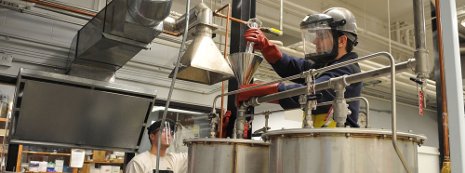Document Type
Article
Publication Date
11-8-2016
Abstract
Background:
Interannual variability in precipitation, particularly drought, can affect lignocellulosic crop biomass yields and composition, and is expected to increase biofuel yield variability. However, the effect of precipitation on downstream fermentation processes has never been directly characterized. In order to investigate the impact of inter-annual climate variability on biofuel production, corn stover and switchgrass were collected during 3 years with significantly different precipitation profiles, representing a major drought year (2012) and 2 years with average precipitation for the entire season (2010 and 2013). All feedstocks were AFEX (ammonia fiber expansion)-pretreated, enzymatically hydrolyzed, and the hydrolysates separately fermented using xylose-utilizing strains of Saccharomyces cerevisiae and Zymomonas mobilis. A chemical genomics approach was also used to evaluate the growth of yeast mutants in the hydrolysates.
Results:
While most corn stover and switchgrass hydrolysates were readily fermented, growth of S. cerevisiae was completely inhibited in hydrolysate generated from drought-stressed switchgrass. Based on chemical genomics analysis, yeast strains deficient in genes related to protein trafficking within the cell were significantly more resist-ant to the drought-year switchgrass hydrolysate. Detailed biomass and hydrolysate characterization revealed that switchgrass accumulated greater concentrations of soluble sugars in response to the drought and these sugars were subsequently degraded to pyrazines and imidazoles during ammonia-based pretreatment. When added ex situ to normal switchgrass hydrolysate, imidazoles and pyrazines caused anaerobic growth inhibition of S. cerevisiae.
Conclusions:
In response to the osmotic pressures experienced during drought stress, plants accumulate solu-ble sugars that are susceptible to degradation during chemical pretreatments. For ammonia-based pretreatment, these sugars degrade to imidazoles and pyrazines. These compounds contribute to S. cerevisiae growth inhibition in drought-year switchgrass hydrolysate. This work discovered that variation in environmental conditions during the growth of bioenergy crops could have significant detrimental effects on fermentation organisms during biofuel production. These findings are relevant to regions where climate change is predicted to cause an increased incidence of drought and to marginal lands with poor water-holding capacity, where fluctuations in soil moisture may trigger frequent drought stress response in lignocellulosic feedstocks.
Publication Title
Biotechnology for Biofuels
Creative Commons License

This work is licensed under a Creative Commons Attribution 4.0 International License.
Recommended Citation
Ong, R. G.,
Higbee, A.,
Bottoms, S.,
Dickinson, Q.,
Xie, D.,
Smith, S. A.,
Serate, J.,
Pohlman, E.,
Jones, A. D.,
Coon, J. J.,
Kato, T. S.,
Sanford, G. R.,
Eilert, D.,
Oates, D. G.,
Piotrowski, J. S.,
Bates, D. M.,
Cavalier, D.,
&
Zhang, Y.
(2016).
Inhibition of microbial biofuel production in drought-stressed switchgrass hydrolysate.
Biotechnology for Biofuels,
9(237).
http://doi.org/10.1186/s13068-016-0657-0
Retrieved from: https://digitalcommons.mtu.edu/chemical-fp/2
Version
Publisher's PDF


Publisher's Statement
© The Author(s) 2016. Deposited here in compliance with publisher policies. Publisher's version of record: http://dx.doi.org/10.1186/s13068-016-0657-0